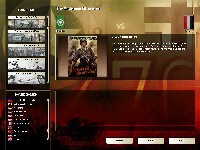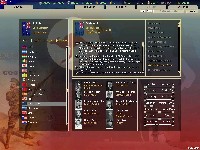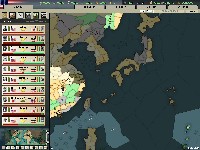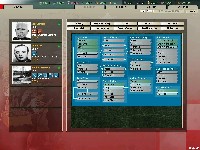Genre: Strategy
Publisher: Paradox Interactive
Developer: Paradox Interactive
Release Date: January 4, 2005
Buy 'HEARTS OF IRON 2': PC
Let's pretend for a moment that you've spent almost all of your Christmas cash and are standing in front of the "H" section in your local retailer with just enough money to buy a mid-priced game. While we're playing pretend, let's also pretend that, like me, you got scared off by every other Paradox game created because their size, scope, and overall complexity made rocket science look like Romper Room
I'm not going to lie to you here — Hearts of Iron 2 is still one complicated game. If you've never played any of Paradox's games, you might think it's like Axis and Allies where you can just jump into it and learn it. It's not. Your learning time here is going to be measured in days, not hours; HOI2 has more in common with Avalon Hill's Rise and Decline of the Third Reich than Axis and Allies. The good news is it's deep and complicated in the way it should be: learning the subtleties of the game and becoming successful, not in just learning how to play the game.
Hearts of Iron 2 is an hour-by-hour simulation of the World War II from 1936-1947, where you control the economic, political and military fate of your chosen country. You can play as any nation in the world during the campaign, but you're best served going with one of the major players in the conflict — there's little chance countries like Hungary and Australia will really rise up and win the war. One neat thing is you can reload any saved game and choose another side in the conflict.
My biggest fear going into this review was the game would be too complicated for me to learn. I was pleased to find out that a decent manual, excellent tutorial, and fun starter missions allowed me to ease my way into it. The nice thing is the starter missions also allow you just play a couple of quick scenarios in one evening as opposed to the several evenings you'll need to run the full campaign. Most of the starter missions involve just armed conflict, so you won't need to mess around with the economic and political side.
One of the complaints about the original I read was the economic portion of the game was too unwieldy to learn and required significant babysitting. It seems to be much better here. Each territory gives you a certain amount of oil, energy, metal and minerals. Oil is used to move the units, and the rest are used to build units, factories and the like. There's a technology tree here as well, but you'll use it to have companies (modeled after historical counterparts) develop your new tools. It's remarkably simple, and while you'll still end up messing around with the sliders, it's not ungainly.
One of the changes they've made to the combat system is now units adjacent to the contested territory can take part in the attack, without having to leave their positions. As a result, you will not empty out these territories to take one — or lose them if the attack fails. On the flip side, you can also set units to defend adjacent territories. The combat area is the one place where the interface takes a bit hit, as every attack — successful or not — yields an individual pop up alert; it's almost as bad as browser pop-ups. It will get very unwieldy since you'll get a pop-up on the results of very division that entered combat, so if you send the kitchen sink in to attack, expect to get a boatload of "our attack in Grozykoff was successful" messages. I imagine that because of how the real-time engine works, they couldn't simplify it much, but I'll get into my gripes with the real-time engine later.
Queuing up production is also quite easy. Click on the Production tab, click on the type of unit you want to make, and then "start production," and it will tell you how many Industrial Points it will consume and when it will be ready. There's also a view that will list all the units you have in queue and the overall efficiency their production is running at.
Diplomacy is also handled through a single tab. Click on the country, and the game will list all available options like Declare War, Coup Nation, Offer Trade Agreement and Annex Nation (available if you've captured enough key provinces). You can also initiate general negotiations to trade resources.
There are a lot of useful map views. You van view the map by terrain type, politics, economic (handy for seeing what resources are in a territory), and victory points. While they all have uses, I found myself using the economic and victory point views the most.
While there are a lot of little bits to the game that can make it complicated, Paradox has done an excellent job at easing you into it. The manual is well done and contains useful information, even if it's hard to read (small text on a gray background). As noted earlier, there are excellent tutorials that walk you through the combat, technological and economic areas. There are starter scenarios that allow you just have a quick battle without worrying about the economy.
But the starter scenarios are just child's play; the main portion of the game is the epic scale of the conflict that runs from 1936-1947. It's not something you'll knock off in one night. Running the full conflict can take you 40-50 hours — roughly the length of your average single-player game — but there is a ton of replay ability here. It's unlikely any two runs through the game would be exactly the same even if you played the same country twice, and also being able to play any of the other WWII superpowers easily makes this a game out of which you can get thousands of hours of play. I do wish there were more of a bridge from the starter scenarios to the campaign, so you can get a better handle on the economic angle before having to manage a world at war.
In terms of overall graphics, there's not much to talk about — this is a wargame after all, not Half Life 2. There aren't any 3d graphics with particle effects (thank goodness), but the map is easy to read, and you can find the information you want quickly, so it's a winner in my book. You can also turn off the animated units and use counters — similar to the old cardboard counters from the board games — and I found that view to help out a lot.
The AI is decent and gave me a good challenge at the default setting. A grognard might want to ratchet it up a few notches, but it was fine for me. I still ended up feeling like I was playing "chase this last unit around so I can conquer Belgium" a few times; sometimes the countries just don't know when to give in.
The only big gripe I have with the game is the use of the real-time engine. With the amount of time I ended up having to pause the game, I wish it were turn-based. Turn-based would have allowed me to plan better, been less reactionary, and reduced the amount of pop-ups. I also still feel that an hour-by-hour approach to the war is too granular.
There is a multiplayer component, although it begs the question: why bother? It's too epic and too long-playing to get meaningful multiplayer out of, unless you are playing one of the short scenarios, but that's like inviting a friend over to watch a movie and only watching the previews.
That said, it's an excellent game, with the caveat that you are a fan of this genre. Even though it says "real-time" on the box, it has little in common with what traditional RTS fans would enjoy. It's also worth noting that these people are not the target audience. While it's not for the faint-of-heart, and you're going to need to put some serious hours into learning it (most likely beating your head against the wall several times in the process), the time will be well-spent. Soon, you'll be arguing with your friends about whether moving Germany two clicks towards "Central Planning" on the slider makes a difference.
Score: 8.8/10
More articles about Hearts Of Iron 2









































